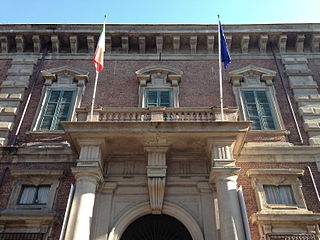
Bernardino Telesio was an Italian philosopher and natural scientist. While his natural theories were later disproven, his emphasis on observation made him the "first of the moderns" who eventually developed the scientific method.

Cosenza is a city located in Calabria, Italy. The city centre has a population of approximately 70,000, while the urban area counts more than 200,000 inhabitants. It is the capital of the province of Cosenza, which has a population of more than 700,000. The demonym of Cosenza in English is Cosentian.

Giambattista Pittoni or Giovanni Battista Pittoni was a Venetian painter of the late Baroque or Rococo period. He was among the founders of the Academy of Fine Arts of Venice, of which in 1758 he became the second president, succeeding Tiepolo.

The Accademia Carrara,, officially Accademia Carrara di Belle Arti di Bergamo, is an art gallery and an academy of fine arts in Bergamo, in Lombardy in northern Italy. The art gallery was established in about 1780 by Giacomo Carrara, a Bergamasco collector or conoscitore of the arts. The academy of fine arts was added to it in 1794. The school was recognised by the Ministero dell'Istruzione, dell'Università e della Ricerca, the Italian ministry of education, in 1988 and in 2023 merged with the Conservatorio Gaetano Donizetti to form the Politecnico delle Arti di Bergamo.

Palazzo Brera or Palazzo di Brera is a monumental palace in Milan, in Lombardy in northern Italy. It was a Jesuit college for two hundred years. It now houses several cultural institutions including the Accademia di Brera, the art academy of the city, and its gallery, the Pinacoteca di Brera; the Orto Botanico di Brera, a botanical garden; an observatory, the Osservatorio Astronomico di Brera; the Istituto Lombardo Accademia di Scienze e Lettere, a learned society; and an important library, the Biblioteca di Brera.

Giovan Paolo Parisio (1470–1522), who used the classicised pseudonym Aulo Giano Parrasio or Aulus Janus Parrhasius, was a humanist scholar and grammarian from Cosenza, in Calabria in southern Italy. He was thus sometimes known as "Cosentius". He was a member of the Accademia Pontaniana of Naples, and founded the Accademia Cosentina, an accademia or learned society in Cosenza, in 1511–12.

The Accademia di Belle Arti di Bologna is a public tertiary academy of fine art in Bologna, in Emilia-Romagna in northern Italy. It has a campus in Cesena.

The Accademia di Belle Arti di Brera, also known as the Accademia di Brera or Brera Academy, is a state-run tertiary public academy of fine arts in Milan, Italy. It shares its history, and its main building, with the Pinacoteca di Brera, Milan's main public museum for art. In 2010 an agreement was signed to move the accademia to a former military barracks, the Caserma Magenta in via Mascheroni. In 2018 it was announced that Caserma Magenta was no longer a viable option, with the former railway yard in Via Farini now under consideration as a potential venue for the campus extension.
The Accademia Nazionale delle Scienze, or more formally L'Accademia Nazionale delle Scienze detta dei XL, and also called the Accademia dei XL, is Italy's national academy of science. Its offices are located within the Villino Rosso, at the corner of via L. Spallanzani and via Siracusa, Villa Torlonia, Rome.

The Archdiocese of Cosenza-Bisignano a Latin diocese of the Catholic Church in Calabria and has been a metropolitan see since 2001.
Giovanni Maria Cornoldi was an Italian Jesuit academic, author, and preacher.

The Royal Academy of Italy was a short-lived Italian academy of the Fascist period. It was created on 7 January 1926 by royal decree, but was not inaugurated until 28 October 1929. It was effectively dissolved in 1943 with the fall of Mussolini, and was finally suppressed on 28 September 1944. All of its functions and assets, including the Villa Farnesina, were passed to the Accademia Nazionale dei Lincei. Until 25 April 1945 it continued some activity in the Villa Carlotta on Lake Como near Tremezzo in Lombardy.

The Accademia delle Arti del Disegno is an academy of artists in Florence, in Italy. It was founded on 13 January 1563 by Cosimo I de' Medici, under the influence of Giorgio Vasari. It was initially known as the Accademia e Compagnia delle Arti del Disegno and consisted of two parts: the company was a kind of guild for all working artists, while the academy was for more eminent artistic figures of the Medici court, and supervised artistic production in the Duchy of Florence.

The Academia della Farnesina, also known as the Accademia fascista maschile di educazione fisica or Accademia fascista della Farnesina, was a centre for sport and political education in Fascist Italy.
Accademia often refers to:
Libera Trevisani Levi-Civita was an Italian mathematician born in Verona.
Gianfranco Cimmino was an Italian mathematician, working mathematical analysis, numerical analysis, and theory of elliptic partial differential equations: he is known for being the first mathematician generalizing in a weak sense the notion of boundary value in a boundary value problem, and for doing an influential work in numerical analysis.

Vettor Fausto or Vittore Fausto (1490–1546) was Venetian Renaissance humanist and naval architect. He was an expert in Greek and the classics. He worked as a copyist and a soldier in his youth. His studies led him to propose the construction of a quinquereme, a galley with five rowers per bench. He published original poetry in Greek, had a hand in the publication of the Complutensian Polyglot Bible and edited classical texts for publication, most notably the Aristotelis Mechanica, which he translated into Latin. In his later years he grew disillusioned with Venetian politics, even being accused of treason.

The Accademia dei Gelati was a learned society of intellectuals, mainly noblemen, that significantly influenced the cultural and political life of Baroque Bologna. It is considered one of the most important 17th-century Italian academies.

Luigi Fera was an Italian lawyer and politician. He was the first Calabrian politician to have prominent and enduring ministerial roles.














